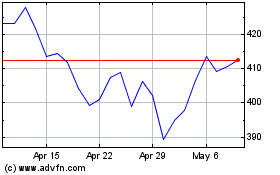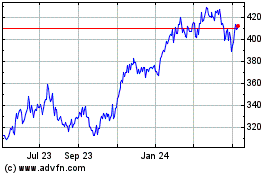Microsoft Shows Strong Growth in Gaming, Cloud -- 3rd Update
April 27 2021 - 6:04PM
Dow Jones News
By Aaron Tilley
Microsoft Corp. extended its pandemic-fueled run of strong
quarterly earnings that have bolstered investor enthusiasm in the
software giant, bringing the company near a $2 trillion
valuation.
Microsoft has seen massive growth across its professional and
consumer businesses with people stuck at home and remote work and
distance education becoming the norm for many. That has driven
rapid uptake of its cloud-computing services and supercharged the
company's videogaming sales. Microsoft's stock is up around 50%
over the past year, driving the company's valuation to about $1.97
trillion, second only to Apple Inc.
"Over a year into the pandemic, digital adoption curves aren't
slowing down. They're accelerating, " Microsoft Chief Executive
Satya Nadella said in a statement.
The Redmond, Wash., company posted a 19% increase in its fiscal
third-quarter sales to about $41.7 billion, generating net income
of $15.5 billion for the January through March period. The results
beat Wall Street expectations, according to FactSet.
Microsoft shares retreated around 3% in after-hours trading
after a strong run-up in the stock ahead of earnings.
"Now there are worries about the sustainability of Microsoft
post-pandemic," said Rishi Jaluria, an analyst for investment
research firm D.A. Davidson & Co.
Microsoft's hardware sales were affected by chip shortages, said
Kyle Vikström, a director of investor relations at the company. The
impact was chiefly on its Xbox gaming consoles and Surface laptops,
she said.
The company's videogaming activity has been particularly hot
during the pandemic. Xbox content and services revenue increased
34% in the latest quarter aided by the recent release of two new
consoles, Xbox Series X and S. Xbox hardware revenue more than
tripled from the previous year.
Revenue from Surface laptops, which have been popular with
people working and learning from home, rose 12% from a year ago.
Surface sales are expected to decline in the current quarter, Chief
Financial Officer Amy Hood said on an analyst call, in part because
of the chip-supply issues.
Strong demand for cloud services late last year helped Microsoft
reverse a trend of a gradually declining pace of growth. The
company said sales linked to Azure cloud services advanced 50% in
the most recent quarter, on par with the December quarter.
Azure, the collection of a global network of data centers and
software tools Microsoft sells as a service, last year became a
larger revenue source for the company than its Windows operating
system, Piper Sandler analyst Brent Bracelin has said. Microsoft is
No. 2 in the cloud behind Amazon.com Inc.
Azure growth had been slowing before the pandemic hit as the
business gained scale. Microsoft sees a return to that pattern as
likely.
"We're getting into the law of large numbers" on Azure's growth,
said Microsoft's Ms. Vikström. "We expect over time that it's going
to decelerate as numbers get bigger."
Microsoft also was able to popularize during the pandemic its
Teams workplace collaboration suite that offers features competing
with companies such as Zoom Video Communications Inc. and Slack
Technologies Inc. Teams usage rose from 20 million active users
before the pandemic in November 2019 to reach more than 145 million
today, Mr. Nadella said.
Microsoft also benefited from the broad strength in the
advertising market. Its search advertising business was up 17%, and
ad-spending also helped lift revenue at LinkedIn, the professional
social-media network, by 25%.
Tech rival Alphabet Inc. on Tuesday reported a 34% jump in
first-quarter sales from the year earlier, driven by a surge in
digital ad spending.
Microsoft's Ms. Hood said she expected "another strong quarter"
for the three months ending in June. The company forecast $43.6
billion to $44.5 billion in sales in the three-month period,
beating Wall Street expectations.
--For more WSJ Technology analysis, reviews, advice and
headlines,
sign up for our weekly newsletter
.
Write to Aaron Tilley at aaron.tilley@wsj.com
(END) Dow Jones Newswires
April 27, 2021 18:49 ET (22:49 GMT)
Copyright (c) 2021 Dow Jones & Company, Inc.
Microsoft (NASDAQ:MSFT)
Historical Stock Chart
From Mar 2024 to Apr 2024

Microsoft (NASDAQ:MSFT)
Historical Stock Chart
From Apr 2023 to Apr 2024
